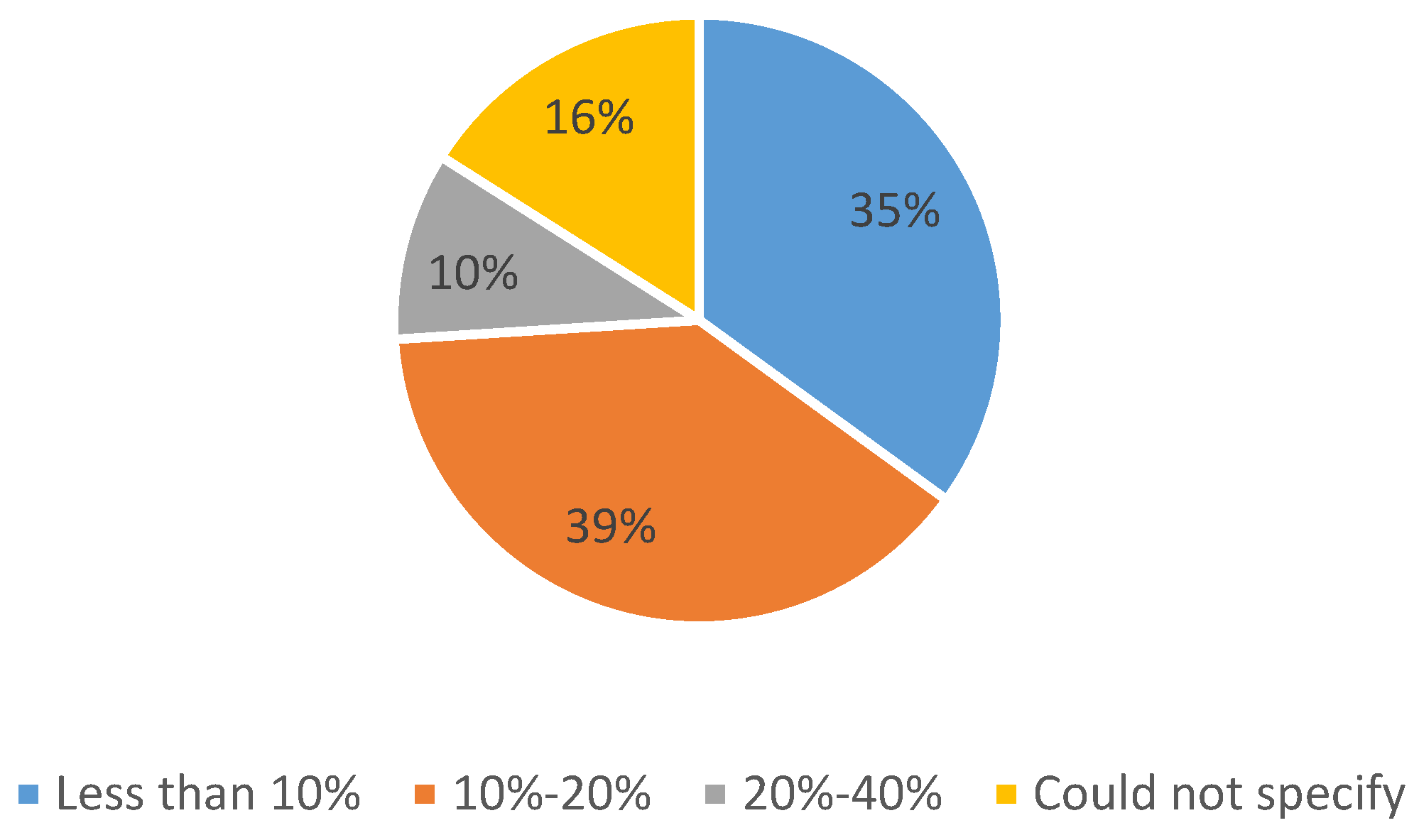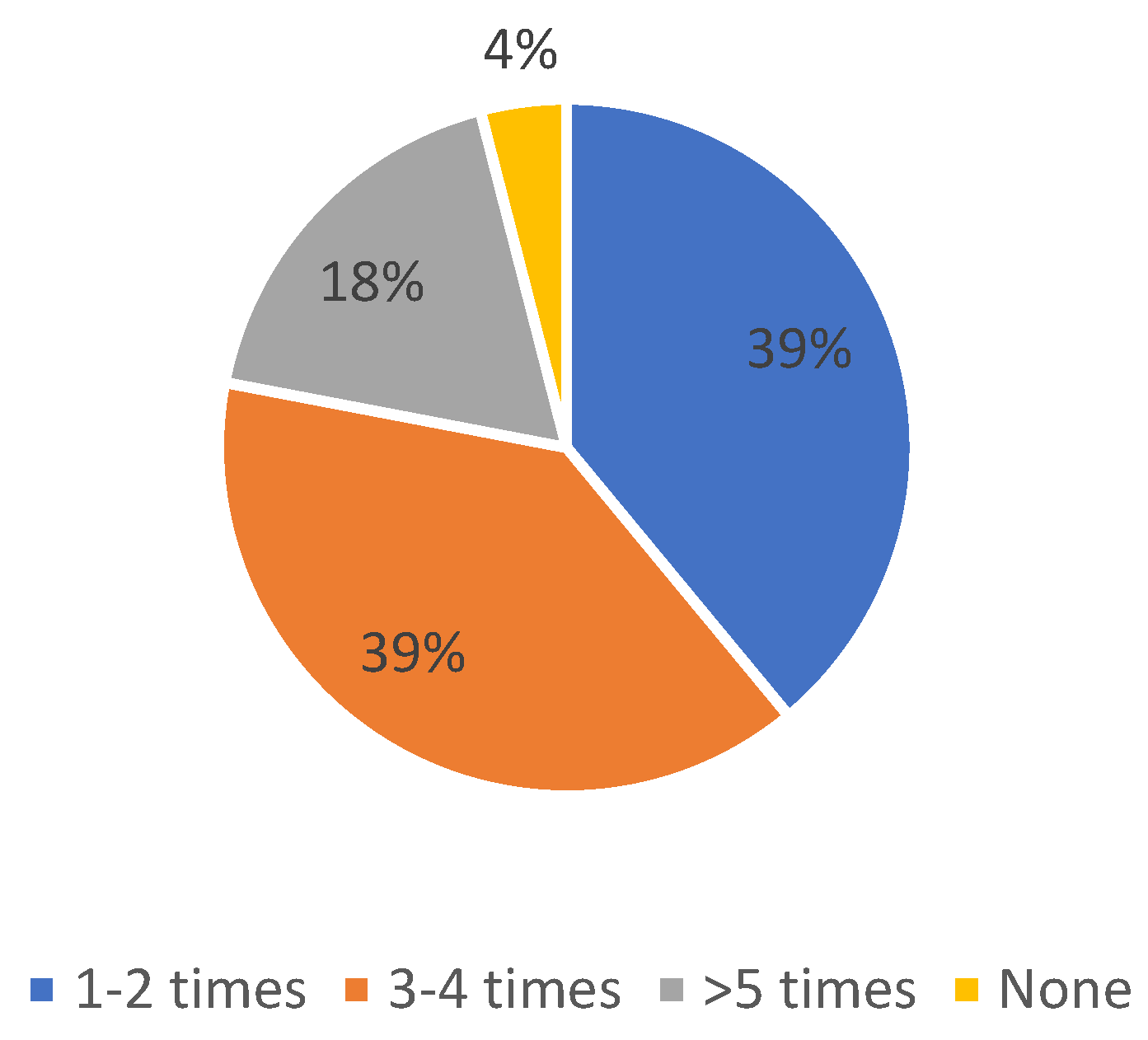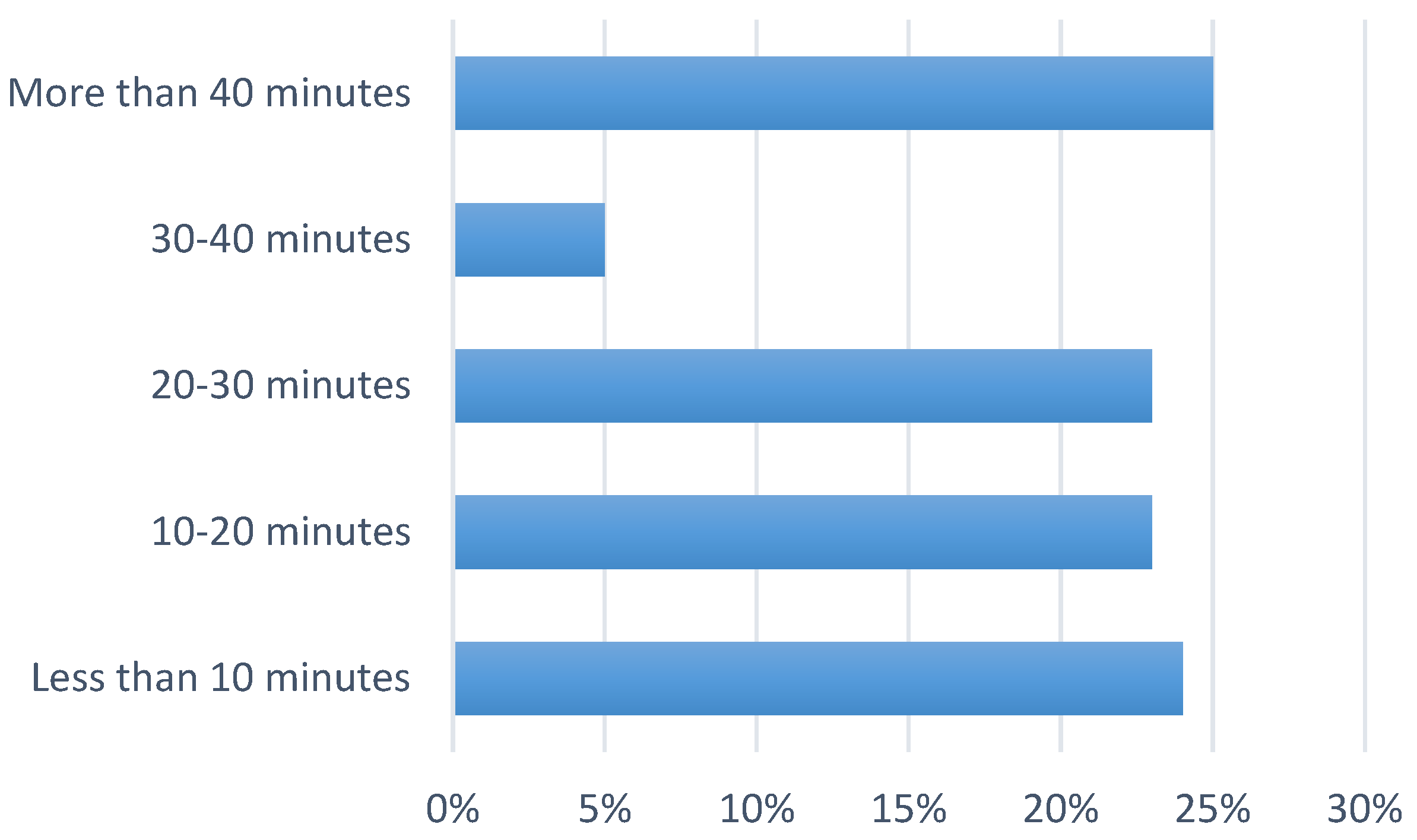Air Quality of Private Interiors during the COVID-19 Pandemic: A Case Study of Dormitory Interiors as Shared Spaces
Abstract
1. Introduction
2. Materials and Methods
2.1. Case Study
2.2. Survey
2.3. Sampling from Bilkent University Dormitories
3. Results
3.1. Findings from Bilkent University Dormitories
3.2. Disinfection and Air Cleaning Methods—Bilkent University
4. Discussion
4.1. Current Status of Air Quality in Bilkent Dormitories
4.2. Perceptions of Sunlight and Natural Ventilation as Disinfection Methods for COVID-19
4.3. Limitation and Future Work
5. Conclusions
Author Contributions
Funding
Institutional Review Board Statement
Informed Consent Statement
Data Availability Statement
Acknowledgments
Conflicts of Interest
Correction Statement
Appendix A
| Question Numbers | Questions |
|---|---|
| 1 | Age |
| 2 | Gender |
| 3 | Dormitory location (University, City and Country) |
| 4 | How many floors does your dormitory have? |
| 5 | Which floor of the dormitory do you live on? |
| 6 | Please indicate the exact floor area (in square meters) of your dormitory room |
| 7 | Please indicate the approximate height of your dormitory room |
| 8 | Please indicate the number of people you share your dormitory room with |
| 9 | What are your daily habits to be in that room? How many times do you leave the room? For how long? |
| 10 | Please indicate the number of hours you spend in this dormitory room in a day |
| 11 | Please indicate the floor material of your dormitory room |
| 12 | Please indicate which direction the windows in your dormitory room face |
| 13 | Please indicate the total number of windows including transparent balcony doors in this area |
| 14 | Please indicate the window location(s) in this area |
| 15 | Please indicate the approximate ratio of the all windows’ area to the whole floor area of your dormitory room area (Tick one circle only) |
| 16 | Please indicate the overall view through the windows(s) in this area |
| 17 | Do you see a greenery area when you look through the windows(s) in this area |
| 18 | Are there any green areas in your dormitory building? |
| 19 | Are there any green areas in a walking distance of your dormitory building (what are their availability, proximity and density)? |
| 20 | Are there any plants in your room? (Tick one circle only) |
| 21 | Do you perceive the presence of sunlight as a disinfection method for COVID-19 droplets? |
| 22 | What are your disinfection and air cleaning methods to control COVID-19 infection in wintertime? |
| 23 | What are your strategies for ventilating your dormitory room in wintertime? |
| 24 | How often do you open your window and/or door in a day in wintertime? |
| 25 | How many minutes do you open your window and/or door in a day in wintertime? |
| 26 | Do you prefer natural or mechanical ventilation in wintertime? |
| 27 | Are you using dryer for your laundry in your dormitory room in wintertime |
| 28 | Are you using any dehumidifier or air purifier in your dormitory room in wintertime? |
| 29 | Are you aware of black moss? If your answer to the above question about black moss is yes, what is your experience and method for getting rid of it? |
| 30 | What methods do you use to disinfect your room in wintertime? |
| 31 | Do you ever used any chemicals for disinfection or insect control? How frequently? |
| 32 | Please write if you have any comments/suggestions related to the survey |
References
- Hobday, R.A.; Dancer, S.J. Roles of sunlight and natural ventilation for controlling infection: Historical and current perspectives. J. Hosp. Infect. 2013, 84, 271–282. [Google Scholar] [CrossRef] [PubMed]
- Sundell, J. On the history of indoor air quality and health. Indoor Air 2004, 14, 51–58. [Google Scholar] [CrossRef] [PubMed]
- Fisk, W.J.; Rosenfeld, A.H. Estimates of improved productivity and health from better indoor environments. Indoor Air 1997, 7, 158–172. [Google Scholar] [CrossRef]
- Kurnitski, J.; Kiil, M.; Wargocki, P.; Boerstra, A.; Seppänen, O.; Olesen, B.; Morawska, L. Respiratory infection risk-based ventilation design method. Build. Environ. 2021, 206, 108387. [Google Scholar] [CrossRef] [PubMed]
- Morawska, L.; Tang, J.W.; Bahnfleth, W.; Bluyssen, P.M.; Boerstra, A.; Buonanno, G.; Cao, J.; Dancer, S.; Floto, A.; Franchimon, F.; et al. How can airborne transmission of COVID-19 indoors be minimised? Environ. Int. 2020, 142, 105832. [Google Scholar] [CrossRef] [PubMed]
- Aviv, D.; Chen, K.W.; Teitelbaum, E.; Sheppard, D.; Pantelic, J.; Rysanek, A.; Meggers, F. A fresh (air) look at ventilation for COVID-19: Estimating the global energy savings potential of coupling natural ventilation with novel radiant cooling strategies. Appl. Energy 2021, 292, 116848. [Google Scholar] [CrossRef] [PubMed]
- Ye, J.; Lin, C.; Liu, J.; Ai, Z.; Zhang, G. Systematic summary and analysis of Chinese HVAC guidelines coping with COVID-19. Indoor Built Environ. 2022, 31, 1176–1192. [Google Scholar] [CrossRef]
- Berry, G.; Parsons, A.; Morgan, M.; Rickert, J.; Cho, H. A review of methods to reduce the probability of the airborne spread of COVID-19 in ventilation systems and enclosed spaces. Environ. Res. 2022, 203, 111765. [Google Scholar] [CrossRef]
- Decker, J.F.; Slawson, R.M. An evaluation of behavioral health compliance and microbial risk factors on student populations within a high-density campus. J. Am. Coll. Health 2012, 60, 584. [Google Scholar] [CrossRef]
- COVID-19 Information Center. COVID-19 Response. Available online: https://www.lincoln.edu/covid-19-information/index.html (accessed on 21 December 2021).
- World Health Organization. Roadmap to Improve and Ensure Good Indoor Ventilation in the Context of COVID-19; Licence: CC BY-NC-SA 3.0 IGO; World Health Organization: Geneva, Switzerland, 2021.
- Bazant, M.Z.; Bush, J.W. A guideline to limit indoor airborne transmission of COVID-19. Proc. Natl. Acad. Sci. USA 2021, 118, e2018995118. [Google Scholar] [CrossRef]
- Aguilera Benito, P.; Piña Ramírez, C.; Viccione, G.; Lepore, E. Ventilation for Residential Buildings: Critical Assessment of Standard Requirements in the COVID-19 Pandemic Context. Front. Built Environ. 2021, 7, 656718. [Google Scholar] [CrossRef]
- Gilani, S.; Montazeri, H.; Blocken, B. CFD simulation of stratified indoor environment in displacement ventilation: Validation and sensitivity analysis. Build. Environ. 2016, 95, 299–313. [Google Scholar] [CrossRef]
- Hamdy, M.H.; Mauro, G.M. Optimizing Hybrid Ventilation Control Strategies Toward Zero-Cooling Energy Building. Build. Environ. 2019, 5, 97. [Google Scholar] [CrossRef]
- Fadaei, A. Ventilation systems and COVID-19 spread: Evidence from a systematic review study. Eur. J. Sustain. Dev. Res. 2021, 5, em0157. [Google Scholar] [CrossRef]
- Hou, J.; Zhang, Y.; Sun, Y.; Song, Y.; Cheng, R.; Luo, S. Occupants’ windows opening behaviour in residences during heating season in Tianjin, China. Procedia Eng. 2017, 205, 2744–2748. [Google Scholar] [CrossRef]
- Sun, Y.; Cheng, R.; Hou, J.; Song, Y.; Luo, S. Investigation on indoor air quality in Tianjin residential buildings. Procedia Eng. 2017, 205, 3811–3815. [Google Scholar] [CrossRef]
- Wallace, L.A.; Emmerich, S.J.; Howard-Reed, C. Continuous measurements of air change rates in an occupied house for 1 year: The effect of temperature, wind, fans, and windows. J. Expo. Sci. Environ. Epidemiol. 2002, 12, 296–306. [Google Scholar] [CrossRef]
- D’Oca, S.; Hong, T. A data-mining approach to discover patterns of window opening and closing behavior in offices. Build. Environ. 2014, 82, 726–739. [Google Scholar] [CrossRef]
- Schweiker, M.; Haldi, F.; Shukuya, M.; Robinson, D. Verification of stochastic models of window opening behaviour for residential buildings. J. Build. Perform. Simul. 2012, 5, 55–74. [Google Scholar] [CrossRef]
- Andersen, R.; Fabi, V.; Toftum, J.; Corgnati, S.P.; Olesen, B.W. Window opening behaviour modelled from measurements in Danish dwellings. Build. Environ. 2013, 69, 101–113. [Google Scholar] [CrossRef]
- Stazi, F.; Naspi, F.; D’Orazio, M. Modelling window status in school classrooms. Results from a case study in Italy. Build. Environ. 2017, 111, 24–32. [Google Scholar] [CrossRef]
- Hewison, M. Vitamin D and immune function: An overview. Proc. Nutr. Soc. 2012, 71, 50–61. [Google Scholar] [CrossRef] [PubMed]
- Bilkent Üniversitesi Yurtları. Yurtlar. Available online: http://yurtlar.bilkent.edu.tr/tr/ (accessed on 21 December 2021).
- T.C. ÇEVRE, ŞEHİRCİLİK VE İKLİM DEĞİŞİKLİĞİ BAKANLIĞI Meteoroloji Genel Müdürlüğü. Resmi İstatistikler. Available online: https://mgm.gov.tr/veridegerlendirme/il-ve-ilceler-istatistik.aspx (accessed on 21 December 2021).
- Kıvanç, D. Relationships between Density, Crowding, Privacy and Dormitory Satisfaction: The Case of Bilkent University Dormitories. Master’s Thesis, Bilkent University, Ankara, Turkey, 2016. [Google Scholar]
- Crowe, S.; Cresswell, K.; Robertson, A.; Huby, G.; Avery, A.; Sheikh, A. The case study approach. BMC Med. Res. Methodol. 2011, 11, 100. [Google Scholar] [CrossRef]
- Lei, Z.; Liu, C.; Wang, L.; Li, N. Effect of natural ventilation on indoor air quality and thermal comfort in dormitory during winter. Build. Environ. 2017, 125, 240–247. [Google Scholar] [CrossRef]
- Sun, Y.; Wang, Z.; Zhang, Y.; Sundell, J. In China, students in crowded dormitories with a low ventilation rate have more common colds: Evidence for airborne transmission. PLoS ONE 2011, 6, e27140. [Google Scholar] [CrossRef] [PubMed]
- Yang, Z.; Shen, J.; Gao, Z. Ventilation and air quality in student dormitories in China: A case study during summer in Nanjing. Int. J. Environ. Res. Public Health 2018, 15, 1328. [Google Scholar] [CrossRef]
- Hou, H.C.; Zhang, D.; Lai, J.H. Qualitative and quantitative investigation into the indoor built environment of modular student housing: A multiple-room case study. Energy Build. 2023, 280, 112734. [Google Scholar]
- Cetin, M.; Abo Aisha, A.E.S. Variation of Al concentrations depending on the growing environment in some indoor plants that used in architectural designs. Environ. Sci. Pollut. Res. 2023, 30, 18748–18754. [Google Scholar] [CrossRef]
- Sevik, H.; Cetin, M. Effects of water stress on seed germination for selected landscape plants. Pol. J. Environ. Stud. 2015, 24, 689–693. [Google Scholar] [CrossRef]
- Cetin, M. A Change in the Amount of CO2 at the Center of the Examination Halls: Case Study of Turkey. Stud. Ethno-Med. 2016, 10, 146–155. [Google Scholar] [CrossRef]
- Ercan, M.S. Your Compass Green “Environmental Indicator”. In Proceedings of the X International HVAC Technology Symposium, Istanbul, Turkey, 30 April–2 May 2012; pp. 169–175. [Google Scholar]
- Rossi, R.; Ceccato, R.; Gastaldi, M. Effect of road traffic on air pollution. Experimental evidence from COVID-19 lockdown. Sustainability 2020, 12, 8984. [Google Scholar] [CrossRef]
- Becher, R.; Øvrevik, J.; Schwarze, P.E.; Nilsen, S.; Hongslo, J.K.; Bakke, J.V. Do Carpets Impair Indoor Air Quality and Cause Adverse Health Outcomes: A Review. Int. J. Environ. Res. Public Health 2018, 15, 184. [Google Scholar] [CrossRef]
- Kleinschroth, F.; Kowarik, I. COVID-19 crisis demonstrates the urgent need for urban greenspaces. Front. Ecol. Environ. 2020, 18, 318. [Google Scholar] [CrossRef]
- Li, Y.; Leung, G.M.; Tang, J.W.; Yang, X.; Chao, C.Y.; Lin, J.Z.; Lu, J.W.; Nielsen, P.V.; Niu, J.; Qian, H.; et al. Role of ventilation in airborne transmission of infectious agents in the built environment-a multidisciplinary systematic review. Indoor Air 2007, 17, 2–18. [Google Scholar] [CrossRef]
- ASHRAE. Handbook HVAC Fundamentals; American Society of Heating, Refrigerating and Air-Conditioning Engineers: Atlanta, GA, USA, 2017. [Google Scholar]
- Azuma, K.; Yanagi, U.; Kagi, N.; Kim, H.; Ogata, M.; Hayashi, M. Environmental factors involved in SARS-CoV-2 transmission: Effect and role of indoor environmental quality in the strategy for COVID-19 infection control. Environ. Health Prev. Med. 2020, 25, 66. [Google Scholar] [CrossRef]
- Ratnesar-Shumate, S.; Williams, G.; Green, B.; Krause, M.; Holland, B.; Wood, S.; Bohannon, J.; Boydston, J.; Freeburger, D.; Hooper, I.; et al. Simulated sunlight rapidly inactivates SARS-CoV-2 on surfaces. J. Infect. Dis. 2020, 222, 214–222. [Google Scholar] [CrossRef]
- Carbonare, N. Occupant-Centered Control Strategies for Decentralized Residential Ventilation. Ph.D. Thesis, KIT-Fakultat fur Architektur des Karlsruher Instituts fur Technologie, Karlsruhe, Germany, 2021. [Google Scholar]
- Hood, A.M. Open-air factors in enclosed systems. Epidemiol. Infect. 1974, 72, 53–60. [Google Scholar] [CrossRef]
- Ransome, A.; Delépine, S.V. On the influence of certain natural agents on the virulence of the tubercle-bacillus. Proc. R. Soc. Lond. 1894, 56, 51–56. [Google Scholar]




| The floor where the room is located | Ground—10% First—23% Second—25% Third—13% Fourth—19% Fifth and above—10% |
| Room surface material | Ceramic tile—50% Wooden parquet—47% Carpet—5% |
| The direction the windows in the room face | North—24% South—20% East—13% West—14% Not specified—29% |
| Number of windows in the room | 1—52% 2—41% 3—7% |
| The overall view through the window(s) in the room | None—30% Some—39% Heavy—31% |
| Green areas are observed through window(s) | 91% |
| Dormitory contains green areas | 55% |
| Green area in walking distance | 99% |
| Rooms with plants | 8% |
| Variable | Freq. of Opening Window in a Day in Wintertime | Window-Opening in Minutes during a Day in Wintertime | Ratio of All Windows’ Area to the Whole Floor Area | The Direction the Window Faces | Number of People Shared | |
|---|---|---|---|---|---|---|
| Freq. of opening window in a day in wintertime | Pearson’s r | — | ||||
| p-value | — | |||||
| Window-opening in minutes in a day in wintertime | Pearson’s r | 0.053 | — | |||
| p-value | 0.589 | — | ||||
| Ratio of the all windows’ area to the whole floor area | Pearson’s r | 0.093 | 0.051 | — | ||
| p-value | 0.344 | 0.605 | — | |||
| The direction the window faces | Pearson’s r | 0.114 | −0.185 | 0.015 | — | |
| p-value | 0.246 | 0.058 | 0.877 | — | ||
| Number of people shared | Pearson’s r | 0.228 | −0.007 | 0.065 | 0.153 | — |
| p-value | 0.019 | 0.944 | 0.509 | 0.117 | — |
Disclaimer/Publisher’s Note: The statements, opinions and data contained in all publications are solely those of the individual author(s) and contributor(s) and not of MDPI and/or the editor(s). MDPI and/or the editor(s) disclaim responsibility for any injury to people or property resulting from any ideas, methods, instructions or products referred to in the content. |
© 2024 by the authors. Licensee MDPI, Basel, Switzerland. This article is an open access article distributed under the terms and conditions of the Creative Commons Attribution (CC BY) license (https://creativecommons.org/licenses/by/4.0/).
Share and Cite
Aslanoğlu, R.; Ulusoy, B.; Kazak, J.K. Air Quality of Private Interiors during the COVID-19 Pandemic: A Case Study of Dormitory Interiors as Shared Spaces. Sustainability 2024, 16, 886. https://doi.org/10.3390/su16020886
Aslanoğlu R, Ulusoy B, Kazak JK. Air Quality of Private Interiors during the COVID-19 Pandemic: A Case Study of Dormitory Interiors as Shared Spaces. Sustainability. 2024; 16(2):886. https://doi.org/10.3390/su16020886
Chicago/Turabian StyleAslanoğlu, Rengin, Begüm Ulusoy, and Jan K. Kazak. 2024. "Air Quality of Private Interiors during the COVID-19 Pandemic: A Case Study of Dormitory Interiors as Shared Spaces" Sustainability 16, no. 2: 886. https://doi.org/10.3390/su16020886
APA StyleAslanoğlu, R., Ulusoy, B., & Kazak, J. K. (2024). Air Quality of Private Interiors during the COVID-19 Pandemic: A Case Study of Dormitory Interiors as Shared Spaces. Sustainability, 16(2), 886. https://doi.org/10.3390/su16020886






